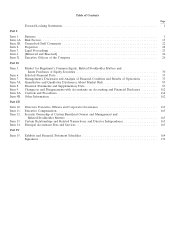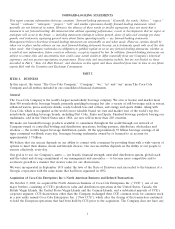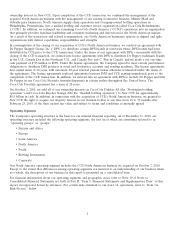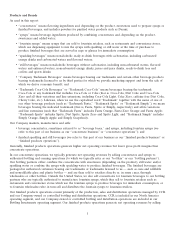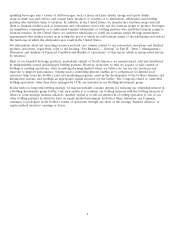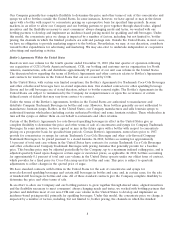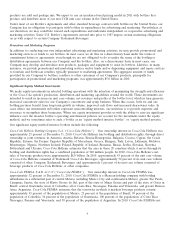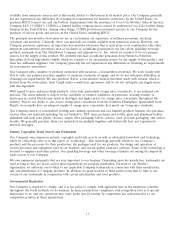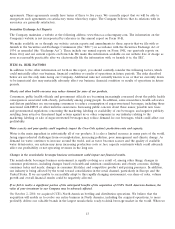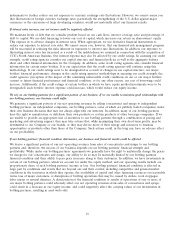Coca Cola 2010 Annual Report Download - page 12
Download and view the complete annual report
Please find page 12 of the 2010 Coca Cola annual report below. You can navigate through the pages in the report by either clicking on the pages listed below, or by using the keyword search tool below to find specific information within the annual report.sales of beverage products were approximately $8.1 billion. In 2010, approximately 62 percent of the unit case volume
of Coca-Cola FEMSA consisted of Trademark Coca-Cola Beverages; approximately 37 percent of its unit case volume
consisted of other Company Trademark Beverages; and less than 1 percent of its unit case volume consisted of beverage
products of Coca-Cola FEMSA or other companies.
Coca-Cola Amatil Limited (‘‘Coca-Cola Amatil’’). Our ownership interest in Coca-Cola Amatil was approximately
30 percent at December 31, 2010. Coca-Cola Amatil has bottling and distribution rights, through direct ownership or
joint ventures, in Australia, New Zealand, Fiji, Papua New Guinea and Indonesia. Coca-Cola Amatil estimates that the
territories in which it markets beverage products contain 100 percent of the populations of Australia, New Zealand, Fiji
and Papua New Guinea, and 98 percent of the population of Indonesia. In 2010, Coca-Cola Amatil’s net sales of
beverage products were approximately $3.7 billion. In 2010, approximately 47 percent of the unit case volume of
Coca-Cola Amatil consisted of Trademark Coca-Cola Beverages; approximately 41 percent of its unit case volume
consisted of other Company Trademark Beverages; and approximately 12 percent of its unit case volume consisted of
beverage products of Coca-Cola Amatil or other companies.
Seasonality
Sales of our ready-to-drink nonalcoholic beverages are somewhat seasonal, with the second and third calendar quarters
accounting for the highest sales volumes. The volume of sales in the beverages business may be affected by weather
conditions.
Competition
Our Company competes in the nonalcoholic beverages segment of the commercial beverages industry. The nonalcoholic
beverages segment of the commercial beverages industry is highly competitive, consisting of numerous companies. These
include companies that, like our Company, compete in multiple geographic areas, as well as firms that are primarily
regional or local in operation. Competitive products include numerous nonalcoholic sparkling beverages; various water
products, including packaged, flavored and enhanced waters; juices and nectars; fruit drinks and dilutables (including
syrups and powdered drinks); coffees and teas; energy and sports and other performance-enhancing drinks; dairy-based
drinks; functional beverages; and various other nonalcoholic beverages. These competitive beverages are sold to
consumers in both ready-to-drink and other than ready-to-drink form. In many of the countries in which we do
business, including the United States, PepsiCo, Inc., is one of our primary competitors. Other significant competitors
include, but are not limited to, Nestl´
e, Dr Pepper Snapple Group, Inc., Groupe Danone, Kraft Foods Inc. and Unilever.
In certain markets, our competition includes beer companies. We also compete against numerous regional and local
companies and, in some markets, against retailers that have developed their own store or private label beverage brands.
Competitive factors impacting our business include, but are not limited to, pricing, advertising, sales promotion
programs, product innovation, increased efficiency in production techniques, the introduction of new packaging, new
vending and dispensing equipment, and brand and trademark development and protection.
Our competitive strengths include leading brands with a high level of consumer acceptance; a worldwide network of
bottlers and distributors of Company products; sophisticated marketing capabilities; and a talented group of dedicated
associates. Our competitive challenges include strong competition in all geographic regions and, in many countries, a
concentrated retail sector with powerful buyers able to freely choose among Company products, products of competitive
beverage suppliers and individual retailers’ own store or private label beverage brands.
Raw Materials
Water is a main ingredient in substantially all of our products. While historically we have not experienced significant
water supply difficulties, water is a limited resource in many parts of the world and our Company recognizes water
availability, quality and the sustainability of that natural resource for both our operations and also the communities
where we operate as one of the key challenges facing our business.
In addition to water, the principal raw materials used in our business are nutritive and non-nutritive sweeteners. In the
United States, the principal nutritive sweetener is high fructose corn syrup (‘‘HFCS’’), a form of sugar, which is
available from numerous domestic sources and is historically subject to fluctuations in its market price. The principal
nutritive sweetener used by our business outside the United States is sucrose, another form of sugar, which is also
10


